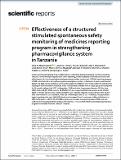Effectiveness of a structured stimulated spontaneous safety monitoring of medicines reporting program in strengthening pharmacovigilance system in Tanzania
Abstract
Under-reporting of adverse drug events (ADEs) is a challenge facing developing countries including Tanzania. Given the high magnitude of under-reporting, it was necessary to develop and assess the effectiveness of a ‘structured stimulated spontaneous safety monitoring’ (SSSSM) reporting program of ADEs which aimed at strengthening pharmacovigilance system in Tanzania. A quasi-experimental design and data mining technique were used to assess the effect of intervention after the introduction of program in seven tertiary hospitals. ADEs reports were collected from a single group and compared for 18 months before (July 2017 to December, 2018) and after the program (January 2019 to June 2020). Out of 16,557 ADEs reports, 98.6% (16,332) were reported after intervention and 0.1% (23) death related to adverse drug reactions (ADRs) were reported. Reports increased from 20 to 11,637 after intervention in Dar es salaam, 49 to 316 in Kilimanjaro and 17 to 77 in Mbeya. The population-based reporting ratio per 1,000,000 inhabitants increased from 2 reports per million inhabitants in 2018 to 85 reports in 2019. The SSSSM program can increase the reporting rate of ADEs and was useful in detecting signals from all types of medicines. This was first effective developed spontaneous program to monitor medicine safety in Tanzania.
Citation
Mwamwitwa , K , Fimbo , A , Bukundi , E , Nkayamba , A , Buma , D , Muro , E , Maganda , B , Shewiyo , D , Shearer , M , Smith , A D & Kaale , E 2022 , ' Effectiveness of a structured stimulated spontaneous safety monitoring of medicines reporting program in strengthening pharmacovigilance system in Tanzania ' , Scientific Reports , vol. 12 , 16131 . https://doi.org/10.1038/s41598-022-19884-0
Publication
Scientific Reports
Status
Peer reviewed
ISSN
2045-2322Type
Journal article
Description
Funding: The study was funded partly by EDCTP under SMERT project and TMDA during SSSSM program implementation and data collection, and ASCEND project during data analysis.Collections
Items in the St Andrews Research Repository are protected by copyright, with all rights reserved, unless otherwise indicated.

